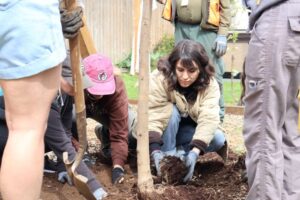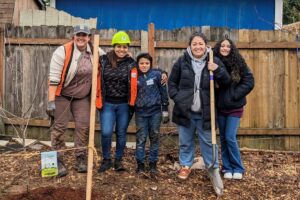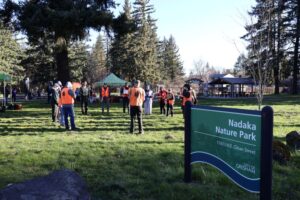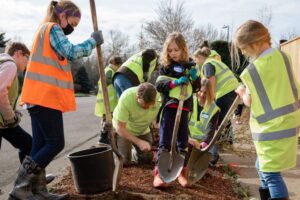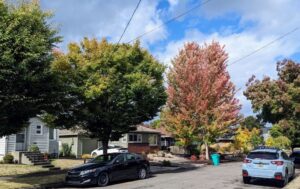Tag: climate change
A Community Forest for the Future
How trees and community can work together in the face of climate change
If you go to Nadaka Nature Park in Gresham, you’ll see plenty of trees. It’s an oasis of shade in East Multnomah County, where many neighborhoods don’t have much shade tree canopy. In June 2021, when the Pacific Northwest was embroiled in a heat dome effect, 72 people died in East Multnomah County. We’ve learned the hardest possible way just how valuable shade can be.
For a lot of people, the Pacific Northwest conjures images of cool, rainy weather and towering trees. They might think of something like Nadaka Nature Park. But many urban neighborhoods in the Pacific Northwest qualify as heat islands, where limited greenery and heat retained by buildings and roads create higher-than-normal temperatures. Even if the heat dome was a rare extreme, climate change is bringing record summer temperatures, and low-canopy neighborhoods are in desperate need of the cooling power of shade trees.
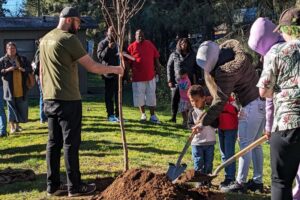
On March 16th, dozens of volunteers gathered at Nadaka on an especially gorgeous morning, eager to plant trees in the surrounding neighborhoods. All of these new trees serve as a memorial to the lives lost to the 2021 Heat Dome and once they’ve matured, they’ll cast shade on homes and sidewalks for decades to come.
“The 2021 heat dome brought us into stark understanding of the vulnerabilities of our neighborhoods, where the shade of trees is a precious resource,” says Yashar Vasef, Executive Director for Friends of Trees.
It’s been nearly three years since that historic heat wave with temperatures as high as 119 degrees Fahrenheit, but for some the memory is still particularly fresh. Several families who lost loved ones during the heat dome joined the volunteers at Nadaka to mark the occasion with intentionality and reflect on the purpose of the planting event. The morning was not a somber one, because, as Multnomah County Chair Jessica Vega Pederson put it in her remarks, “planting a tree is a hopeful act.”
In addition to the trees planted throughout the community that day, there’s a new tree at Nadaka, an American hornbeam planted by the families. Before they filled in the hole, the families added hearts to the soil with the names of those they lost. One family member said they plan to return to the park each year for a family barbecue and to visit and care for the memorial tree.
“This is what it means to grow a community forest,” Yashar says. “Yes, it’s planting trees and creating green spaces where they’re needed most, but it also means getting community members involved. We can build relationships, share knowledge and resources. We can work together to make sure everyone has access to the benefits of trees.”
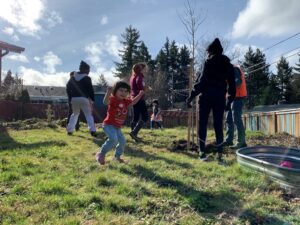
In the face of a changing climate, trees and green spaces improve our lives
If you’ve ever gone for a walk or a jog on a warm sunny day, you might find yourself chasing shade. It’s intuitive that shade is cooler than full sun. But how much cooler? Studies have shown that trees can lower urban temperatures as much as 10 degrees. During a heat wave, that can be lifesaving. The heat dome served as a stark reminder that weather can have a real and devastating impact on people.
Extreme heat is becoming more common, even expected, during summers in the Pacific Northwest. Homes without shade trees will be significantly warmer and will need to rely more on air conditioning during summer months.
“Communities at this higher latitude are arguably the most underprepared for these kinds of events,” Portland State University Professor Vivek Shandas said. “We saw that really bear down on us in 2021.”
The cooling power of shade is a cost-effective way to cool our homes, parks, and sidewalks. We need to preserve the canopy we have, and continue to grow it. New mapping from Multnomah County shows how trees and the built environment impacts temperature.
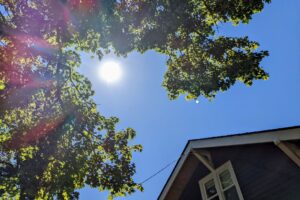
“Not everyone has access to trees and green spaces, which means that they don’t have access to their benefits,” Yashar says. “If we want to grow a true community forest, we need to work to expand that access and plant trees in the most vulnerable communities.”
Beyond cooling, trees have so many benefits. They remove carbon dioxide from the atmosphere and use it to grow, storing carbon that would otherwise contribute to climate change. The more a tree grows, the more carbon it stores. During one year, a mature tree can absorb 48 pounds of carbon dioxide from the atmosphere and release oxygen in exchange.
Even in urban settings, trees provide habitat for wildlife. Take one of our favorites, the oak tree. “You plant an oak in your yard, you’re planting a zoo,” says Douglas W. Tallamy, author of The Nature of Oaks. “It’s your chance to create life that didn’t exist in that space.”
Trees clean our air. Trees improve air quality by providing surface area for airborne particulates to stick to. Those particulates are then washed by rain into the soil, where microorganisms break them down into something less harmful.
Our Clean Air Canopy project is the result of an Oregon Department of Environmental Quality lawsuit against a polluter in the neighborhood. The DEQ fined the facility and granted funds to Friends of Trees and our partners to lead community tree plantings in the area.
That sentiment was shared among volunteers at Clean Air Canopy planting events in Northeast Portland, who were grateful to turn this negative —pollution—into a positive thing for their neighborhood.
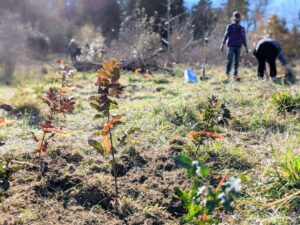
Green Space volunteers feel the same way when they plant in natural areas along streams, because trees and green spaces clean our water, a resource that’s becoming more and more precious. Almost all of our natural area plantings take place alongside a stream. Take the Wilkes Creek Headwaters in outer East Portland. The 20.7-acre hybrid park is nestled in the neighborhood, and provides opportunities for local residents to connect with nature.
The natural area is particularly special because it is home to the headwaters of Wilkes Creek, which flows into the Columbia Slough. Just past the planting site, you can see the natural springs where water comes to the surface and turns into a stream.
“Wilkes Creek is one of the only remaining free-flowing above-ground streams that makes its way into the Columbia Slough,” says Yoko Silk, a Stewardship Coordinator with PP&R. “There used to be hundreds, now there’s only a handful. So it’s really special for being that source of cold, clean water into the slough.”
With all of these benefits, trees and green spaces are an incredibly cost-effective way to improve lives in our communities, regardless of the changing climate. Dr. Geoffrey Donovan, a researcher with the United States Forest Service, wanted to investigate one step further — do trees save lives?
Luckily, Donovan had access to years worth of tree planting data from Friends of Trees. Specifically, he used the planting data from the nearly 50,000 trees that Friends of Trees planted in Portland neighborhoods since 1990.
The study, published in December 2022 in the journal Environmental International, found that each tree planted was associated with significant reductions in non-accidental and cardiovascular mortality. To account for other possible explanations for the mortality rate like race, education, and income, the statistical models incorporated data from the American Community Survey.
As the trees mature, their benefit grows too. Trees planted within the past 11-15 years had twice the impact of trees planted within the last five. The study stops short of proving a definitive causal relationship between planting trees and fewer deaths, but Donovan expressed confidence in his findings, saying, “we do think it’s likely that trees are saving lives in Portland, because we accounted for a lot of other explanations.”
The study went on to associate the reduced death rate with an incredible economic benefit, based on the EPA’s statistical value of a human life.
“In short, trees are cheap and human lives are valuable,” Donovan says.

Picking the right trees for the future
When it comes to trees, there are so many layers to preparedness, from the near to distant future, from the next heat wave or ice storm to what the climate might look like in 25 years. So much of the future is uncertain, but there’s plenty you can do to prepare your trees for what they might encounter.
“So much is unknowable,” says Eugene Director Erik Burke. “You won’t have the information you need to make your decisions when you make them. You just have to make your best guess.”
It starts with planting the right tree in the right place. Sometimes people favor certain species because of sentiment or aesthetic appeal, but if they aren’t planted in a place with the right conditions, they’re more prone to failure. Selecting a tree for the available space, light and soil type is the first step. Considering trees that are adapted to your climate, and what the climate might be in the future, can set your tree up for a long, healthy life.
“People think about what they want in a tree but it might not be a good fit for their property,” says Litzy Venturi, the Community Tree Care Coordinator at Friends of Trees.
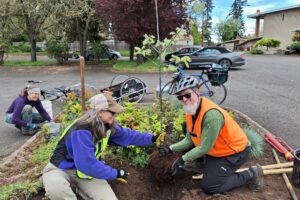
The urban environment presents unique challenges to trees that would otherwise do well in a forest. Concrete and asphalt trap both heat and cold. The soil is often stripped of top soil and compacted. And trees are usually stranding alone, rather than part of a multilayered forest ecosystem.
Climate change only complicates the right tree, right place concept that is at the core of our planting program. Urban spaces are also usually a degree or two warmer than natural areas, which is only made worse by climate change. Some local species, like the western red cedar, are already struggling due to warmer temperatures.
With the climate changing, and potentially dramatically, it makes sense to consider non-native trees that would do well here, especially if they’re drought-tolerant and free of pests and disease.
“For a while, the estimate was that by 2050, Eugene’s climate might be like Sacramento’s is now,” Erik says. “But that estimate is moving even further south to Stockton.”
Erik outlines three approaches that planting programs can take to prepare for climate change. The first is diversity for diversity’s sake. Planting a variety of trees means that if any particular species fails due to climate impacts or disease, it won’t take out a huge chunk of the urban forest. The second is very intentionally looking at trees adapted to our native climate and soils, but many of those species aren’t readily available in the nursery trade. The third is planting broadly adapted trees with huge ranges, but many of those trees aren’t drought tolerant, and because many of those trees are clones, they aren’t given the opportunity to adapt from generation to generation.
“Really, we should do some of each approach,” Erik says. “There are trade-offs for each.”

We must care for trees so that they can care for us
We want trees to not just survive, but thrive. When we think about trees and native plants thriving in the urban environment—and in the face of climate change—we need to think in terms of tolerance.
“Trees can tolerate all sorts of conditions but can they really thrive to their maximum potential size and lifespan?” Litzy says. “Trees are incredible at surviving but they might just be limping along.”
Some trees are more tolerant of pollution, for example, and are good choices to be planted alongside busy roadways. Beyond tolerant, some trees are particularly good at removing particulate from the air. These are the factors we need to consider when making choices about selection. For trees with lower tolerances, that pollution will add stress to the tree that will prevent it from fully thriving.
So many things can put stress on a tree. It’s up to us to mitigate those stressors wherever we can. Some of that can be done when we select the right trees for the right place. But there is still more that we can do for a tree after its planted, especially during its establishment years.
“It’s important to remember that stress is additive,” Erik says. “Even if a tree survives, stress can pile up from heat wave to ice storm to heat wave. That’s why we need to water during heat waves and prune properly after ice storms.”
While heat waves and ice storms are beyond our control, our response to a storm is the first step in preparing for the next one. Erik warns that bad pruning after an ice or wind storm can lead to more failure down the line, because limbs won’t be strong enough for the next. Still, he advocates for proper pruning after storm damage rather than removing a tree.
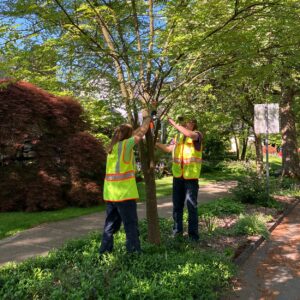
“When you remove a tree, you’re back to square one,” Erik says. “But restorative pruning can give that mature tree a chance to continue providing benefits.”
The more stress a tree has, the more susceptible it is to pests and disease. We’ve had two new pests arrive in Oregon in recent years—the emerald ash borer and Mediterranean oak borer.
“With climate change, we might have to be even more prepared to support trees with water and mulch,” Litzy says. “That extra level of care might help the tree thrive and be able to stave off pests and disease. And even when we plan to water, we don’t want to plant trees that need a lot of water.”
As we see shorter rainy seasons and longer dry seasons, watering becomes an important calculus. Water is critical for photosynthesis—trees need it for food. We may even reach the point where native plants will need water support after establishment.
“It’s so important that we plant in the right conditions and provide care,” Litzy says. “I like to think of healthcare for people. You do preventative care whenever you can, and respond to issues when they arise.”
Selection, tree care, and public education. This is how we reach what Erik calls our ultimate goal: to have a healthy relationship with trees. That’s why it’s important to find opportunities to talk about trees.
“Weather and climate is something everyone experiences,” says Taylor Glass, Eugene-Springfield Program Manager. “It’s something to connect over. It’s a way to talk about climate change.”
“My hope is that it will cause us to cooperate more,” Erik says.
“We’re going to have to,” Taylor says.
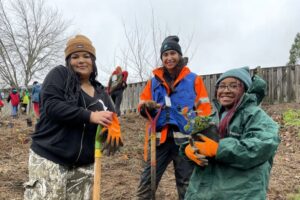
Creating the next generation of climate champions
Last October, a group of high schoolers from the Cascade Education Corps led three classes from CF Tigard Elementary in a natural area planting at Woodard Park. Before the students got to plant, our Green Space Specialist Kaitie Benedek asked the elementary schoolers a simple—and big—question: “Why are we here today?”
The kids were quick to answer. “Climate change!” “Oxygen” “Food for animals!” “To plant more trees than we take down.”
Already, these kids are becoming the next generation of environmental stewards. They recognize the benefits of trees and green spaces, from fighting climate change and providing habitat to cleaning our air and water. And they wanted to maximize their impact by planting as much as they could in a single class period.
“We’d have classes of 25 at a time planting for one class period, so it was super fast,” Kaitie says. “So many kids got excited about planting, and about getting to contribute to this park right by their school. A lot of the kids even named their plants.”
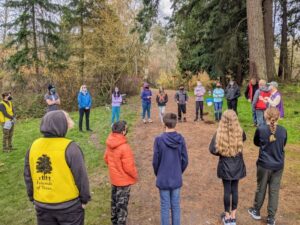
Students from Cascade Education Corps (CEC) helped lead the plantings. CEC members are high school students following an alternative path to graduation by working on hands-on environmental projects. With elementary, middle and high schoolers working together and people walking by in the park offering encouragement, the plantings at Dirksen and Woodard had a wonderful intergenerational feel to them.
“When you get students involved in learning about the environment, appreciating the place and engaging with it, they’ll take those lessons home and share them,” says Green Space Specialist Meng Vue.
Recently, the latest cohort of Friends of Trees’ Adult Urban Forestry and Restoration Training Program finished its 10-week curriculum and moved into their internship phase. The program is designed to increase career opportunities for underrepresented communities in the urban forestry and natural area restoration fields. Many of those participants come to Friends of Trees through Connecting Canopies, which offers a 9-month training in urban forestry and restoration to BIPOC young adults. Their time with Friends of Trees is one piece of that training, focused on a community approach to planting trees.
“When people work in the forestry or restoration field, their skills and knowledge trickle down into their community,” says Theresa Huang, Partnerships & Planning Manager at the Urban Greenspaces Institute.
Cata Krznarich participated in the program last year. Their pursuit of a career in the environmental realm is rooted in the idea of reconnection.
“Growing up in California in the woods, I had the access and privilege to be a natural space,” Cata says. “When I moved into the city, I felt like I was pushed out of my home and way of living. I went to school for environmental science and I’ve done a lot of internships to get back to nature and that sense of home.”
Cata joined the Connecting Canopies and Adult Urban Forestry programs to find career pathways into the environmental field. By meeting people who work in the field, they were exposed to real world possibilities. For Cata, it’s important to focus on putting a real dent in climate change, an issue that for many can feel too big and abstract to tackle.
“Climate change is really front and center in my mind,” they say. “It comes to mind first thing every morning with my first cup of coffee. I do try to read a lot of positive climate justice news because the negative stuff can be very daunting and very scary. And then I finish my coffee and get to work to put a little dent.”
Cata can always find reasons to be hopeful—like when “seeing flowers come up where I don’t expect.” Community, too, brings them hope. Being part of the Connecting Canopies cohort helped them see the impact that a group of people can have when they work together.
“Working with my cohort, when everyone has that same passion, it can feel like more than a dent when we plant 50 ponderosa pine trees on a rainy day.”
For Cata, our relationship with the land is intricately related to climate change, and reconnection to the land provides a path forward. Their next internship is with Elderberry Wisdom Farm, where they’ll learn more about Traditional Ecological Knowledge, habitat restoration, and climate justice.
“Something that brings me hope is seeing native people getting their land back, that restoration and healing. I’m always asking, how can we heal? Putting our hands in the ground and our feet back in the ground will help us all reconnect and understand our own impact”
A community forest built by community climate action
This year, an 11-member coalition led by Friends of Trees is putting into action a $12 million Urban and Community Forestry Grant from the U.S. Department of Agriculture, part of the Inflation Reduction Act (IRA) grants. The grant will fund the engagement of low canopy neighborhoods included in the Biden-Harris Administration’s Justice40 initiative, which will bring resources to communities most impacted by climate change, pollution, and environmental hazards.
The driving theme of the IRA Project is coalition building.
Coalition building goes hand-in-hand with Friends of Trees’ mission to grow community by planting and caring for trees and natural areas together. While we are proud of our past and existing partnerships, this new project is an unprecedented opportunity to take our approach to partnering to the next level by more meaningfully and responsively collaborating with community stakeholders. This includes carving the time and capacity to connect as project partners and people.
Partners like POIC are working to create the next generation of environmental stewards by connecting high school youth with career training. They’re regular crew leaders at Friends of Trees planting events, and the coalition grant will help support their work.
Depave will help communities transform over-paved spaces into urban greenery. APANO, another coalition partner, is finding ways to connect with community members in the project area.
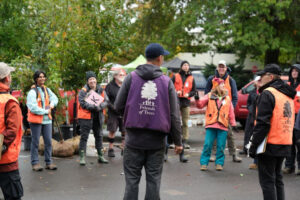
“When have we ever had 11 different organizations coming together as one coalition for a cohesive goal? It’s really awesome,” says Alisa Kajikawa, APANO’s Community Development Manager for the Jade District. “Hopefully this is a case study for the future, showing what happens when we stop working in silos and work toward a shared goal in different ways.”
This coalition grant is just one investment in growing a community forest, one that will hopefully set a blueprint for the transformational climate action we urgently need.
A community forest is a lot of things. It’s the trees, plants, and animals that live in our neighborhoods. It’s the way they contribute to the environment by cleaning air and water, creating habitat, and fighting climate change.
And it’s us. How we work together to build an equitable urban forest, where everyone has access to trees and green spaces. How we take care of that urban forest as the valuable resource that it is. How we foster an ethic of stewardship for people and urban nature alike.
“These times in our world are troubled and the news is often grim; each time I participate in a Green Space planting I receive a huge dose of hopefulness.”
-Anonymous volunteer
From Eugene to Vancouver, when volunteers show up to a planting event and put their hands in the earth, they’re taking real climate action. When thousands of volunteers take climate action, they’re growing a community forest, one that will support us into the future, no matter how uncertain.
A Memorial for Lives Lost in the 2021 Heat Dome
72 trees planted for 72 lives lost in Multnomah County
On March 16th at Nadaka Nature Park in Gresham, dozens of volunteers gathered on an especially gorgeous morning, eager to plant trees. While all of our events are climate action, this one had particular significance. All of these new community trees will serve as memorial to the lives lost to the 2021 Heat Dome. The Arbor Day Foundation funded the planting of 50 yard trees in addition to the 72 memorial street trees, providing much needed shade to these neighborhoods.
“The 2021 heat dome has brought us into stark understanding of the vulnerabilities of our neighborhoods, where the shade of trees is a precious resource,” says Yashar Vasef, Executive Director for Friends of Trees.
It’s been nearly three years since that historic heat wave with temperatures as high as 119 degrees Fahrenheit, but for many the memory is still fresh. Several families who lost loved ones during the heat dome joined the volunteers at Nadaka to mark the occasion with intentionality and reflect on the purpose of the planting event. The morning was not a somber one, because, as Multnomah County Chair Jessica Vega Pederson put it in her remarks, “planting a tree is a hopeful act.”
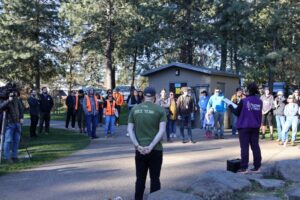
As summer approaches, and with it a chance for another heat wave, it’s important to remember both short and long-term preparedness. We must protect the trees we have, and continue to grow our canopy, especially in neighborhoods that are designated as heat islands.
“In the face of such tragedies, it is imperative that we act decisively on the things we can control,” Yashar says. “Our efforts to plant trees are a stance against the worst outcomes of climate change.”
After remarks from leaders, crews of volunteers headed out into East County neighborhoods to plant street and yard trees that will shade the community. And family members gathered to plant an American hornbeam at Nadaka Nature Park in memory of their loved ones. One family member said they plan to return to the park each year for a family barbecue and to visit and care for the memorial tree.
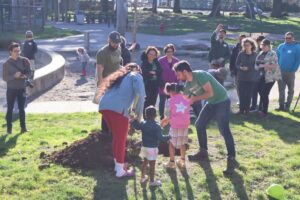
“Each tree we planted helps build a shield against the worst humanitarian impacts of extreme heat,” Yashar says, “and serves as a testament to our shared commitment to building a safer, more resilient community.”
***
The memorial planting event was organized by Friends of Trees, Multnomah County, and the City of Gresham.
Preparing Eugene Trees for Climate Change
What we can do in the face of an uncertain future
When it comes to trees, there are so many layers to preparedness, from the near to distant future, from the next heat wave or ice storm to what the climate might look like in 25 years. So much of the future is uncertain, but there’s plenty you can do to prepare your trees for what they might encounter.
“So much is unknowable,” says Eugene Director Erik Burke. “You won’t have the information you need to make your decisions when you make them. You just have to make your best guess.”
The very first decision you’ll make is what tree to plant. Considering trees that are adapted to your climate, and what the climate might be in the future, can set your tree up for a long, healthy life.
“For a while, the estimate was that by 2050, Eugene’s climate might be like Sacramento’s is now,” Erik says. “But that estimate is moving even further south to Stockton.”
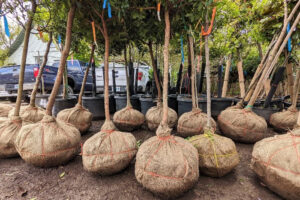
Erik outlines three approaches that planting programs can take to prepare for climate change. The first is diversity for diversity’s sake. Planting a variety of trees means that if any particular species fails due to climate impacts or disease, it won’t take out a huge chunk of the urban forest. The second is very intentionally looking at trees adapted to our native climate and soils, but many of those species aren’t readily available in the nursery trade. The third is planting broadly adapted trees with huge ranges, but many of those trees aren’t drought tolerant, and because many of those trees are clones, they aren’t given the opportunity to adapt from generation to generation.
“Really, we should do some of each approach,” Erik says. “There are trade offs for each.”
What about trees that are already in the ground? How do we prepare our large trees? Our Eugene Team always emphasizes the importance and value of regular pruning. Appropriate pruning will set a tree up to survive in the urban environment and in the face of weather events.
“It’s important to remember that stress is additive. Even if a tree survives, stress can pile up from heat wave to ice storm to heat wave.” Erik says. “That’s why we need to water during heat waves and prune properly after ice storms.”
How we respond to storms is the first step in preparing for the next one. Erik warns that bad pruning after an ice or wind storm can lead to more failure down the line, because limbs won’t be strong enough for the next. Still, he advocates for proper pruning after storm damage rather than removing a tree.
“When you remove a tree, you’re back to square one. But restorative pruning can give that mature tree a chance to continue providing benefits.”
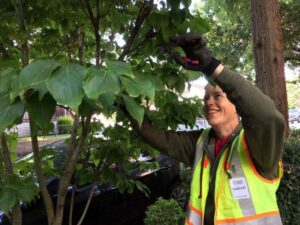
Selection, siting, pruning, protecting soil, and public education. This is how we reach what Erik calls our ultimate goal: to have a healthy relationship with trees. That’s why it’s important to find opportunities to talk about trees.
“Weather and climate is something everyone experiences,” says Taylor Glass, Eugene-Springfield Program Manager. “It’s something to connect over. It’s a way to talk about climate change.”
“My hope is that it will cause us to cooperate more,” Erik says.
“We’re going to have to,” Taylor says.
Together we can protect trees and our communities: Friends of Trees Op-Ed
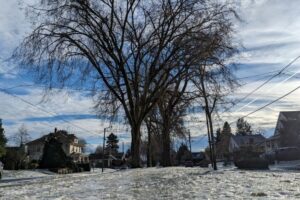
On January 21st, The Oregonian published an op-ed written by Yashar Vasef, our executive director, and Litzy Venturi, our community tree care coordinator: “We must invest in tree care to protect trees and our communities.” Read the full piece below.
Opinion: We must invest in tree care to protect trees and our communities
Climate change and its severe impacts force us to live with dual realities: We need trees more than ever and we need to recognize that extreme weather can turn them into hazards. After hundreds of trees and large limbs fell around the Portland metro area during this historic winter storm, we know that people may be concerned about the trees in their neighborhoods. The impact of a downed tree is serious and often devastating.
The response is clear, but not necessarily easy. Not only do we need to continue to plant trees to grow our urban canopy, but we also need to invest more time, knowledge and resources into assessing, protecting and maintaining the trees we have. As part of that, we must also deal with trees that need to be removed and replaced due to poor health or the potential threat they pose to homes or businesses.
Trees are a crucial ingredient for a healthy, resilient and livable community. How do we set our trees up for success in the face of potential extreme weather? It starts with planting the right tree in the right place. Sometimes people favor certain species because of sentiment or aesthetic appeal, but if they aren’t planted in a place with the right conditions, they’re more prone to failure. Selecting a tree for the available space, light and soil type is the first step in giving a tree a long healthy life.
The next step is to invest in caring for young trees after they’re planted. Proper watering techniques encourage roots to spread into a wide, stable network. Mulching around a tree’s root zone provides the soil with needed nutrients and structure. The right pruning plan will allow a tree to establish a strong trunk and a stable shape and mitigate the risk of limb failure. Tree care is a lot like preventative medicine. Keeping a tree healthy will reduce the risk of catastrophic failure.
You might be looking at a large tree in your own yard and wondering what to do next. While concern after this winter storm is natural, it’s important to remember that the benefits of trees far outweigh the risks. Trees create oxygen, abate pollution and cool our neighborhoods. It’s important not to over-correct by removing healthy trees. This was an unusually catastrophic weather event, and while hundreds of trees fell, millions didn’t. Still, there are steps you can take as a tree owner, and that we can take as a community, to better care for our trees and reduce the risk of catastrophe in the future.
An arborist partner of ours, Chad Honl, pointed out in a recent Oregonian/OregonLive story that this was “a perfect storm for knocking over trees,” and that even trees he would have characterized as stable toppled over in the storm. That’s a scary prospect, especially as climate change increases chances for extreme weather. But it just means that we need to learn more about what happened – which kinds of trees fell and what factors may have made some more vulnerable to failing than others. We agree with Honl’s call for trees to be assessed and reassessed with storms like this in mind. Understanding and addressing risks in advance of the next storm can save a lot of money, trouble and even lives. If you’re worried about your tree, you should have it inspected by a certified arborist for maintenance needs and potential problems.
A greater investment in trees doesn’t just mean planting more trees. It means taking care of the trees we have. In response to the unexpected revenue from the Portland Clean Energy Fund, Portland City Commissioner Carmen Rubio has called for additional climate investments, including $100 million for the protection and maintenance of 240,000 right-of-way street trees between the sidewalk and the street. We need to protect our mature trees and protect our communities by making sure those trees are safe.
The more mature a tree gets, the more benefits it provides: more carbon storage, more air and water quality benefits, more shade, more habitat. That’s why we need to invest in the health of our trees, for our safety in the event of a winter storm or heat wave, for our daily mental and physical well-being, and for the health of the planet.
Save Our State’s Urban Trees from Tree Code Rollback
Governor Kotek’s HPAC proposes overriding tree codes in favor of development.
Governor Kotek’s Housing Production Advisory Council (HPAC) is currently planning to bring forward recommendations that include the overriding of tree codes for plots smaller than 6,000 square feet, which will explicitly allow clear cutting of trees under 48″ diameter, which includes the vast majority of urban trees. This recommendation stands in stark contrast to work taking place throughout the state and nation to increase tree cover as a key tool for growing climate-resilient cities. Read more here.
HPAC has a hearing on Friday, September 29th where this facet of their proposal will be discussed.
We recognize the urgent need for affordable housing, but housing and trees should not be mutually exclusive. Friends of Trees, the Shade Equity Coalition (we’re a member!), and many other environmental organizations around the state believe the proposal is unnecessarily pitting the housing and climate emergencies against one another. Unfortunately, this advisory body in question does not have a representative from the environmental justice sector to speak to shade equity, climate change, and the myriad of benefits urban trees provide to Oregonians. This is our chance to voice our concerns.
HOW TO TESTIFY
Since it is difficult to testify at the hearing itself, please make sure to submit written testimony to: [email protected] and copy [email protected].
Suggested Talking Points from Trees for Life Oregon
—At a time of climate crisis, throwing climate- and tree-related regulations out the window is a misguided, short-sighted way to speed up housing construction—and a sure way to guarantee that the state and its cities and towns will be unable to meet their own planned climate and canopy goals.
—Many factors affect developers’ ability to build more affordable housing faster. Tree protections are hardly key among them. Portland’s tree code gives developers the option of paying fees to remove trees in lieu of preserving them. Builders have been paying these fees as they do other business expenses, deeming them worth it in order to build more revenue-generating units or a larger single home whose price will more than cover any tree-removal fees they might have paid. Moreover, simply doing away with tree protections will not guarantee that builders will create more affordable housing.
—We oppose HPAC’s proposal to essentially override municipal tree codes like Portland’s that took many people many years and much effort to put into place. Tree codes were created to ensure Oregon remains a livable place we can all be proud to live in. The Portland tree code, for one, was in the end strongly influenced by developers and is already weak as is.
—We oppose HPAC’s recommendations to erode state and local wetland and environmental zone protections. Such changes will certainly impact trees.
—Governor Kotek’s HPAC is proposing to do away with environment regulations that developers have wanted to eliminate for years. When selecting HPAC’s members Governor Kotek did not include broader voices that would reflect the reality that we are facing both a housing and a climate crisis, and that both need to be addressed in an integrated way.
We hope you’ll take this opportunity to let your voice be heard.

